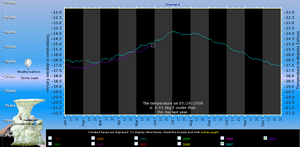According to UAH: Daily averaged temperatures of the Earth are measured by the AMSU flying on the NOAA-15 satellite. The satellite passes over most points on the Earth twice per day, at about 7:30 am and 7:30 pm local time. The AMSU measures the average temperature of the atmosphere in different layers from the surface up to about 135,000 feet or 41 kilometers. During global warming, the atmosphere near the surface is supposed to warm at least as fast as the surface warms, while the upper layers are supposed to cool much faster than the surface warms.
But as I understand it, the lower troposphere is supposed to be closely coupled to CO2 induced forcings. As we've seen from comparison to surface data sets such as HadCRUT, the UAH MSU lower troposphere tracks fairly well with surface temps.
You can learn more about how the Advanced Microwave Sounder Unit on NOAA-15 works and what coverage it has here at my post on it the instrument.
According to the UAH data For 2008, we are averaging about .4 to .5 degrees C cooler than last year.
See the graph and click it for a larger image:

|
| ©UAH |
This tracks with some of the anecdotal evidence we've been seeing in the weather in the northern hemisphere this spring, with late snowfalls, late frosts, and below normal temperatures. The northern latitude areas such as Canada have been very slow to have a spring season.



Reader Comments
to our Newsletter